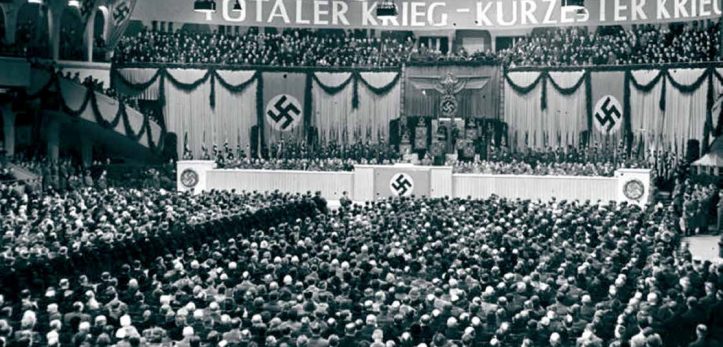The Anti-Catholic Propaganda of German National Socialism. Part 2.
Author: Grzegorz Kucharczyk,
"Love One Another!" 33/2015

From 1935, a large number of monks and priests were put on trial on charges of gross indecency, involving paedophile acts of a homosexual nature. The purpose was – as Hitler announced – to make the Catholic clergy appear as “common criminals”.

First: deprive priests of their good name
Vilifying the Catholic Church in the eyes of German public opinion was to be achieved not only through accusations of “countless treasures” being hidden in monasteries. Monks – and the Catholic clergy in general – were not only portrayed as “layabouts”; officials of the ministry headed by Joseph Goebbels disseminated opinions of monasteries as “dens of debauchery and perversion.”
From 1935, a large number of monks and priests were tried on charges of gross indecency, paralleled by those of “foreign exchange offences.” In the former case, it was mostly paedophile acts of a homosexual nature that were meant. The largest number of such trials were held between April and August 1937, certainly not by accident. Let us remember that in March 1937, Pious XI’s anti-Nazi encyclical Mit brennender Sorge [With burning anxiety], dealing with the Church and the German Reich, was read out in all churches across Germany, in spite of the official ban imposed by the authorities of the Third Reich and the increased vigilance of the Gestapo and political police (SD).
The very fact that the Nazi authorities (on Hitler’s explicit orders) “froze” (for instance, during the Berlin Olympics in 1936) and “unfroze” (see above) these trials is clear evidence that they were not intended as a means of revealing the truth or administering justice, or as efforts to improve public morality. Their purpose was altogether different: a propaganda effect was sought, whereby – as Hitler announced – the Catholic clergy would be presented as “common criminals”.
The aim was also to convince readers that hideous practices (homosexuality, paedophilia) were pursued not by a negligible fraction of the clergy
In 1935–1937, gross indecency trialsin Germany ended in the conviction of 64 clergymen (monks and diocesan priests) and 170 lay brethren. Even ignoring the fact that some of the convicted had already been expelled from their respective orders by the relevant Church authorities for licentiousness (e.g. 60 lay brethren), the figures meant that the trials affected as few as 0.23 per cent of the entire German clergy,so not even a quarter of a per cent. This, however, did not prevent Goebbels’s propaganda machine from trumpeting about “thousands of accused and convicted”. Not by accidental was the preparatory stage in all these proceedings taken away from public prosecutors answerable to the Ministry of Justice and supervised by the security service of the Reich (SD) and the Gestapo. From the beginning, Goebbels personally oversaw the designing of a propaganda strategy intended as a major blow to the Church. The trials were needed only as much as they supplied “credible” arguments to the propaganda machine.
Guidelines for the media on how to vilify the clergy
The Reich’s Ministry of Propaganda,which had controlled the entire press market in Germany since 1933, kept issuing directives and instructions for the press concerning how to “properly” report on the trials. To begin with, they insisted that the subject of the “immorality” of the Catholic clergy “exposed” at the trialsbe given continuous coverage in the press. As Goebbels himself said in an interview for the Nazi newspaper Volkischer Beobachter in July 1936, the aim was to “wisely dispense” information. This aim was served by Goebbels’s instruction not to publish courtroom pictures when a trial of priests started in a city. Such pictures could be published only aftera month, in order to stoke the public’s flagging interest in the trial.
Another propaganda technique employed by the Nazi press was to regularly publish “letters to the editor” venting outrage at “that growth on the healthy body of the people” as the Catholic clergy was branded in the context of the trials. This technique had been well tested over a decade earlier in the “godless” Bolshevik press in Russia, which carried letters from “concerned readers” who “strongly objected to the policies of the reactionary and backward Orthodox Church”.
Goebbelsian propaganda tried not only to create the impression that “all decent Germans” were outraged at “what was going on in the monasteries”, but also to convince readers that hideous practices (homosexuality, paedophilia) were pursued not by a negligible fraction of the clergy, but that they were a “systemic matter”, the tip of the iceberg, and that “the entire system, the whole Roman lot, is depraved to the core”.
Unrivalled in following the guidelines of the Ministry of Propaganda, Volkischer Beobachter, the largest newspaper in Germany and the official press organ of the NSDAP,wrote in June 1937 that putting Catholic priests and monks on trial for gross indecency meant “exposing a system whereby thousands of priests commit spiritual violence — one priest commits a crime against morality, other priests cover it up with the help of confession, and still others attempt to hide the covering up from the public gaze”.
Setting aside the treatment of the sacrament of penance as a “covering-up tactic”, characteristic of the Nazis,it is worth noticing another propaganda measure, the so-called law of large numbers: “thousands of priests”, “thousands of crimes”, etc. The aim was to create the impression that immoral behaviour was not something marginal, but rather typical of the Catholic clergy.
Goebbels speaks – the strategy of lying in a nutshell
The pinnacle of the smear campaign against the Catholic Church in Germany in 1935–1937 was a “classic” speech of Nazi hate delivered by Goebbels in Berlin’s Deutschlandhalle on 28 May 1937, pre-arranged in minute detail, with the designated enemy this time not Jews or Poles but the Catholic Church in Germany.
This speech by Goebbels is important inasmuch as it brought together all the strands of the propaganda directed at the Church since 1935. We have everything here: exaggerations, generalisations, the “law of large numbers”, instilling unreasonable fear (“what might they do to your children?”) and a ready-made solution (still more National Socialism).
The Reich’s Minister of Propaganda told thousands of NSDAP members that the trials “exposed a widespread decline in morality [in the Catholic Church] on such a terrifying and outrageous scale that an equivalent can hardly be found in the entire cultural history of mankind”. And further, in agreement with the law of large numbers, “Thousands of clergymen and lay brethren, thousands of Church sexual offenders practised the planned moral destruction of thousands of children and the sick”.
In March 1937, Pius XI’s anti-Nazi encyclical Mit brennender Sorge was read out in all churches across Germany, in spite of the official ban imposed by the authorities of the Third Reich and the increased vigilance of the Gestapo and political police (SD)
Thus it is not surprising — the chief of Nazi propaganda continued — that “the hearts of millions of German parents are seized by fear for the safety of their children” sent to Catholic schools to be educated. However, there was a solution for all the anxious, a credible alternative. Schools ran by “corrupt, unscrupulous seducers of minors” (read: Catholic clergy) were contrasted by Goebbels with “the fresh, candid and broad-minded upbringing of youth” in National Socialist schools. Let there be no doubt: “in Germany, the law of the Vatican is not binding, but the law of the German peopleis”, and “the Führer — and he alone — is called upon to guard the German youth and the German national spirit”.
What was the propaganda supposed to cover up?
In this way, Goebbels revealed the most important aim of the Nazi regime, for which the smear campaign against the Catholic clergy was merely “paving the way”. In reality, the Catholic Church was to be deprived of any influence over the intellectual and, above all, spiritual formation of young Germans. This — according to Goebbels, who was only repeating the views of Hitler – should pass completely to the state, ridden by Nazi ideology.
Tellingly, the propaganda attack coincided with the attack on Catholic schools and the teaching of religion in state schools in the German Reich. In 1935, a nationwide ban was imposed on founding and expanding private schools. This category comprised mostly schools run by churches and denominational groups, including the Catholic Church.
In 1936, a financial blow was delivered to schools operated by Catholic religious congregations. They were subjected to taxation (until then they had been exempted) and refused state subsidies, which had been provided until then to help meet the operational costs of such schools.
The planned reform of the Reich’s entire school system was designed to rid it completely of Catholic schools. As the Minister of Public Education, Bernhard Rust, wrote to Hermann Göring on 9 February 1940: “There is no space for private denominational schools in [the school system reform], because their one-sided, denominational educational objectives are at odds with the [educational] objectives of National Socialism”.
The first steps to establishing a complete monopoly of the NSDAPin the German school system coincided with Goebbels’s ministry launching the smear campaign against the clergy. The artificially created media brouhaha was meant to cover up the news of the gradual abolition of Catholic schools in Germany.
In 1936, in Bavaria — the most Catholic of all German states – the process of removing from state schools 1,700 monks, friars and nuns, who had taught religion began. It continued in spite of protests by bishops (e.g. Cardinal Faulhaber of Munich), leaving about 1,200 catechists unemployed by 1938. In practice, this meant that the teaching of religion was removed from schools in the most Catholic region of Germany.
In 1939, the Third Reich authorities set up an All-German Private School Union. Membership was obligatory for all private schools that intended to operate in Germany.Schools run by Catholic orders naturally applied, but to no avail: all applications were turned down. Thus, a formal pretext was created to close down all Catholic schools in Nazi Germany.
On 2 October 1939, the Minister of Education, Bernhard Rust, issueda decree that “by Easter 1940, all denominational schools will be closed”. The Nazi minister’s decree was meticulously put into effect, and by the end of the 1939/1940 school year there were no Catholic schools left in Germany.
Source: https://loamagazine.org/archive/2015/2015-33/the-anti-catholic-propaganda-of-german-national-socialism-part-2
The article was published with the permission from "Love One Another!" in September 2020.
Submit
your article!
Read
more articles - Free!
Need
translation jobs? Click here!
Translation
agencies are welcome to register here - Free!
Freelance
translators are welcome to register here - Free!
Subscribe
to TranslationDirectory.com newsletter - Free!
Take
part in TranslationDirectory.com poll - your voice counts!
|





